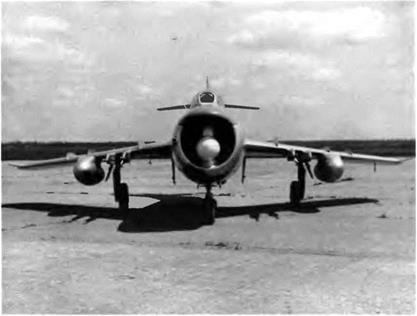MiG 17R / SH-2 SR 2s/MiG-17F
The SR-2, derived from a MiG-17F airframe, was designed to study the feasibility of a frontline photo-reconnaissance aircraft powered by the new VK-5F turbojet. The preliminary designs of the SR-2 and VK-5F were ordered by decree no. 2817-1338 signed on 3 August 1951 by the USSR council of ministers. Strangely, the aircraft’s performance data were not described in the council’s specifications. The structure of the cannon tray was now riveted; new equipment included a MAG-9 tape recorder and a special AFA-BA-21s camera capable of taking oblique, vertical, or double-corridor-wide photos. A hydraulic servo-control was added to the elevator control, and the instrument panel was rearranged once more.
The VK-5F was rated at 2,940 daN (3,000 kg st) maximum dry thrust and 3,775 daN (3,850 kg st) with reheat. Its afterburner was much more efficient than that of the VK-1F thanks to an increase in turbine inlet temperature, the use (for the first time) of refractory alloys resistant to thermal stress for turbine blades, and better cooling. Because of this new technology the reheated thrust was 460 daN (470 kg st) greater than that of the VK-1F—but the size, weight, and specific fuel consumption of the two engines were identical. The VK-5F was certainly an unqualified success for the Klimov OKB.
To counterbalance the weight of the SR-2 camera set, the N-37D cannon was removed. The two NR-23s with 100 rpg were retained. The pilot could use the tape recorder to note all of his observations while flying a mission, saving him the bother of taking notes on his plotting chart or remembering a lot of details until debriefing time. The camera was attached to a tilting tray that permitted to take either single – or double-corridor vertical or oblique photos with a 30-degree setting angle in relation to the horizontal (on the left side of the flight path). Small protective flaps that opened automatically before each shot were flushed into the skin of the fuselage just in front of the camera lens. While the aircraft was on the ground these flaps remained closed, protecting the lens against foreign objects The AFA-BA-21s camera could be replaced by the more sophisticated AFA-BA-40R. The SR-2 was equipped with a curtain-type ejection seat fitted with stabilizing panels.
The aircraft was rolled out in May 1952 and made its first flight under A. N. Chemoburov in June. Factory tests continued for quite a long time—until January 1954 The state acceptance trials were conducted concurrently, lasting from July 1952 until 10 August 1954. They were earned out by two military pilots, S. A. Mikoyan and P. N Belyas – mk both wing commanders. The state test report concluded: "1. The SR-2, powered by a VK-5F turbojet has passed its state acceptance trials. 2. Entry into service of a VK-5F-powered MiG-17R has no justification, since its performance is not very different from that of the VK-1F – powered MiG-17F. 3. On the other hand, we recommend the production of the MiG-17R powered by the VK-1F and with the same camera installation." Thus, while the SR-2 met the state’s specifications, it was not recommended for air force units But the SR-2s—which carried the same photographic equipment as the SR-2 but was powered by a VK-1F engine—was accepted after a series of tests as the air force’s frontline daytime photo-reconnaissance aircraft and, surprisingly, named the MiG-17F. In this case the "F" stood for fotografia (photography) and not forsirovanie (reheat), as is commonly presumed.
The following details refer to the SR-2.
|
The MiG-17PFU was equipped with the RP 1 Izumrud radar and could carry two slipper tanks with a capacity of 400 1 (106 US gallons) apiece |
Specifications
Span, 9.628 m (31 ft 7 in), length, 11 36 m (37 ft 3.2 in); height, 3 8 m (12 ft 5.6 in), wheel track, 3.849 m (12 ft 7 5 in), wheel base, 3 368 m (11 ft 0.6 in), wing area, 22.6 m2 (243.3 sq ft); takeoff weight, 5,350 kg (11,790 lb), wing loading, 236.72 kg/m2 (48.5 lb/sq ft)
Performance
Max speed, 1,132 km/h (611 kt); service ceiling, 16,800 m (55,100 ft); range with two 600-1 (158-US gal) drop tanks, 2,115 km (1,313 mi), climb to 5,000 m (16,400 ft) in 2 min











